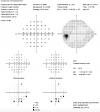Review of Vitreopapillary Traction Syndrome
- PMID: 33012906
- PMCID: PMC7518309
- DOI: 10.1080/01658107.2020.1725063
Review of Vitreopapillary Traction Syndrome
Abstract
Vitreopapillary traction (VPT) syndrome is a potentially visually significant disorder of the vitreopapillary interface characterised by an incomplete posterior vitreous detachment with the persistently adherent vitreous exerting tractional pull on the optic disc and resulting in morphologic alterations and a consequent decline of visual function. It is most commonly unilateral but bilateral reports have also been described. The cause of the condition may be unknown or idiopathic, although the histology of traction shows proliferation of fibrous astrocytes, myofibroblasts, fibrocytes, and retinal pigment epithelial cells. It is theorised that VPT may induce a congested optic disc with neuronal dysfunction as well as decreased prelaminar flow. The present study reviews and summarises the features, diagnosis, and management of VPT.
Keywords: Vitreopapillary traction; optic disc; optic neuropathy; posterior vitreous detachment; visual field loss.
© 2020 Taylor & Francis Group, LLC.
Figures



